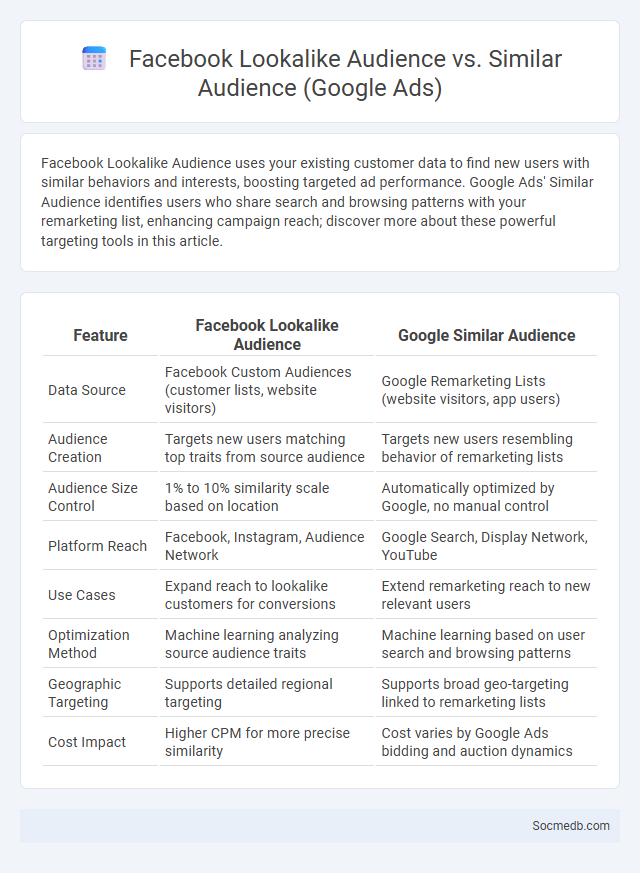
Photo illustration: Facebook Lookalike Audience vs Similar Audience (Google Ads)
Facebook Lookalike Audience uses your existing customer data to find new users with similar behaviors and interests, boosting targeted ad performance. Google Ads' Similar Audience identifies users who share search and browsing patterns with your remarketing list, enhancing campaign reach; discover more about these powerful targeting tools in this article.
Table of Comparison
| Feature | Facebook Lookalike Audience | Google Similar Audience |
|---|---|---|
| Data Source | Facebook Custom Audiences (customer lists, website visitors) | Google Remarketing Lists (website visitors, app users) |
| Audience Creation | Targets new users matching top traits from source audience | Targets new users resembling behavior of remarketing lists |
| Audience Size Control | 1% to 10% similarity scale based on location | Automatically optimized by Google, no manual control |
| Platform Reach | Facebook, Instagram, Audience Network | Google Search, Display Network, YouTube |
| Use Cases | Expand reach to lookalike customers for conversions | Extend remarketing reach to new relevant users |
| Optimization Method | Machine learning analyzing source audience traits | Machine learning based on user search and browsing patterns |
| Geographic Targeting | Supports detailed regional targeting | Supports broad geo-targeting linked to remarketing lists |
| Cost Impact | Higher CPM for more precise similarity | Cost varies by Google Ads bidding and auction dynamics |
Introduction to Audience Targeting in Digital Advertising
Audience targeting in digital advertising leverages data on user demographics, interests, and online behavior to deliver highly personalized content on social media platforms. By utilizing tools such as Facebook Pixel, Google Analytics, and advanced segmentation techniques, marketers can optimize ad spend and increase engagement rates. Precise targeting enhances campaign performance by reaching relevant users, driving higher conversion rates and improved return on investment (ROI).
Understanding Facebook Lookalike Audience
Facebook Lookalike Audience helps you target new potential customers who share similar characteristics with your existing audience, improving the efficiency of your ad campaigns. This tool uses data from your source audience, such as website visitors, app users, or customer lists, to find users with matching behaviors, demographics, and interests. Leveraging Lookalike Audiences enables Your marketing efforts to reach high-quality prospects likely to engage with your brand.
Exploring Similar Audience in Google Ads
Exploring similar audiences in Google Ads enables you to target users who share characteristics with your existing customers, enhancing the efficiency of your social media campaigns. By leveraging machine learning algorithms, Google identifies new potential customers based on behaviors, interests, and demographics. This approach optimizes Your ad spend, increasing reach and engagement with highly relevant prospects.
What is a Generic Lookalike Audience?
A Generic Lookalike Audience is a type of target group created by social media advertising platforms that mirrors the characteristics of a source audience, often based on user demographics, interests, and behaviors. This audience is generated using machine learning algorithms that analyze data points from existing customers or website visitors to find new potential users who share similar patterns. Marketers use Generic Lookalike Audiences to expand reach efficiently while maintaining high relevance and engagement in campaigns.
Key Differences: Facebook vs Google Ads Audiences
Facebook Ads audiences are primarily defined by user demographics, interests, and behaviors derived from extensive social interactions, enabling highly targeted social engagement campaigns. Google Ads audiences leverage search intent and online activity across the web and YouTube, focusing on keyword intent, website visits, and purchase behavior for intent-driven targeting. Understanding these key differences helps you tailor ad strategies to either build brand awareness through Facebook's social graph or capture high-intent users with Google's intent-based audience segments.
Data Sources and Audience Creation Process
Social media platforms utilize diverse data sources, including user behavior, demographics, and engagement metrics, to build comprehensive audience profiles. This data is processed through algorithms that segment users based on interests, preferences, and interactions, enabling precise audience targeting. Your business can leverage these insights to create tailored advertising campaigns that effectively reach and engage the desired audience segments.
Reach, Accuracy, and Scalability Comparison
Social media platforms vary significantly in reach, with Facebook offering over 2.9 billion monthly active users, providing the widest global audience access. Accuracy in targeting is enhanced through advanced algorithms on platforms like LinkedIn, which utilize professional data for precise audience segmentation. Scalability is demonstrated by Twitter's real-time engagement capability, supporting rapid content dissemination across millions of users worldwide.
Cost and Performance Metrics Analysis
Analyzing social media cost and performance metrics enables you to optimize your advertising budget by identifying which platforms yield the highest return on investment (ROI) per dollar spent. Key performance indicators like cost per click (CPC), cost per acquisition (CPA), and engagement rates provide quantifiable insights into campaign effectiveness and audience interaction. Leveraging data analytics tools to monitor these metrics helps maximize your marketing impact while minimizing unnecessary expenditures.
Use Cases: Choosing the Right Audience for Your Campaign
Selecting the right audience for your social media campaign directly impacts engagement, conversion rates, and ROI by targeting users most likely to respond positively. Utilizing advanced tools like Facebook Audience Insights and LinkedIn Campaign Manager enables precise segmentation based on demographics, interests, and behavior patterns. Tailoring your messaging to resonate with defined audience personas ensures your campaign delivers relevant content that drives meaningful interaction and brand loyalty.
Best Practices for Leveraging Lookalike and Similar Audiences
To maximize social media campaign performance, leverage lookalike and similar audiences by analyzing high-value customer data and using it to create precise audience segments. Employ continuous audience testing and refinement based on engagement metrics to enhance targeting accuracy and conversion rates. Incorporate exclusions of existing customers or underperforming segments to optimize budget allocation and increase return on ad spend.
 socmedb.com
socmedb.com